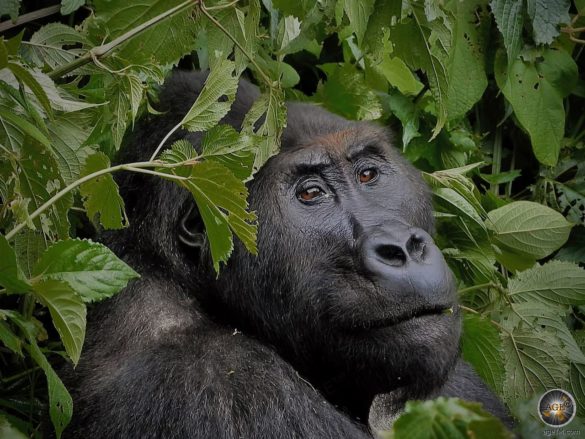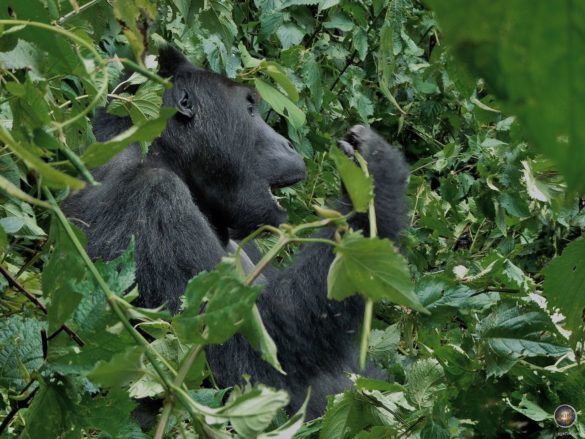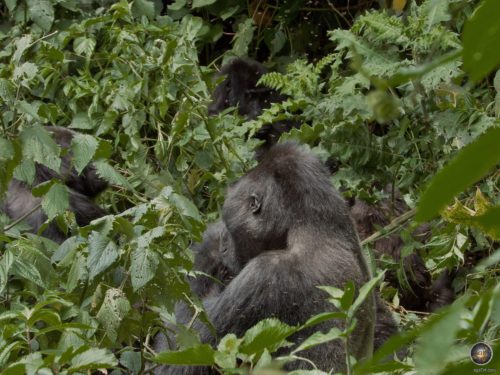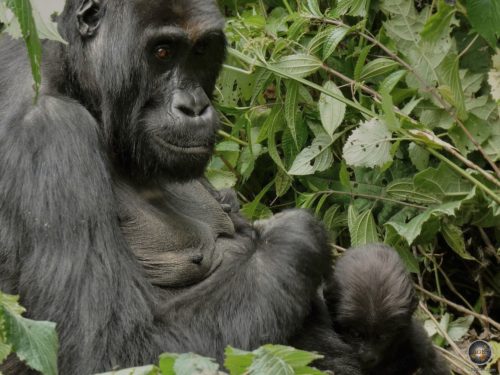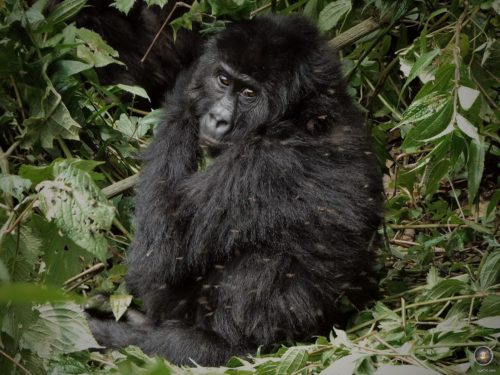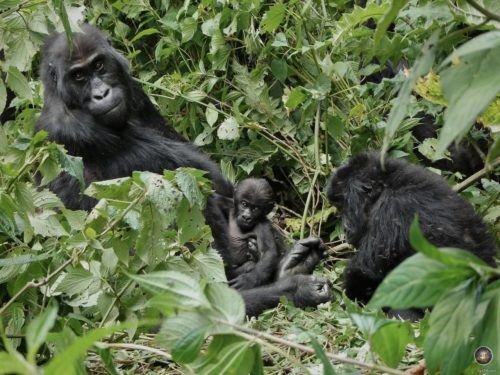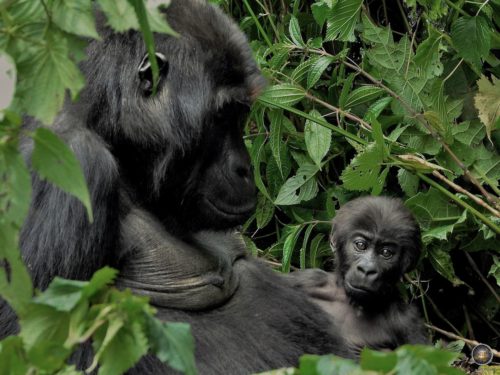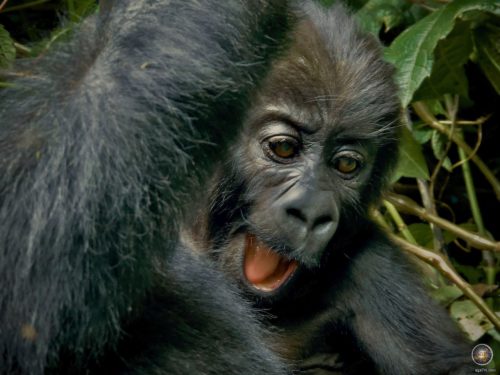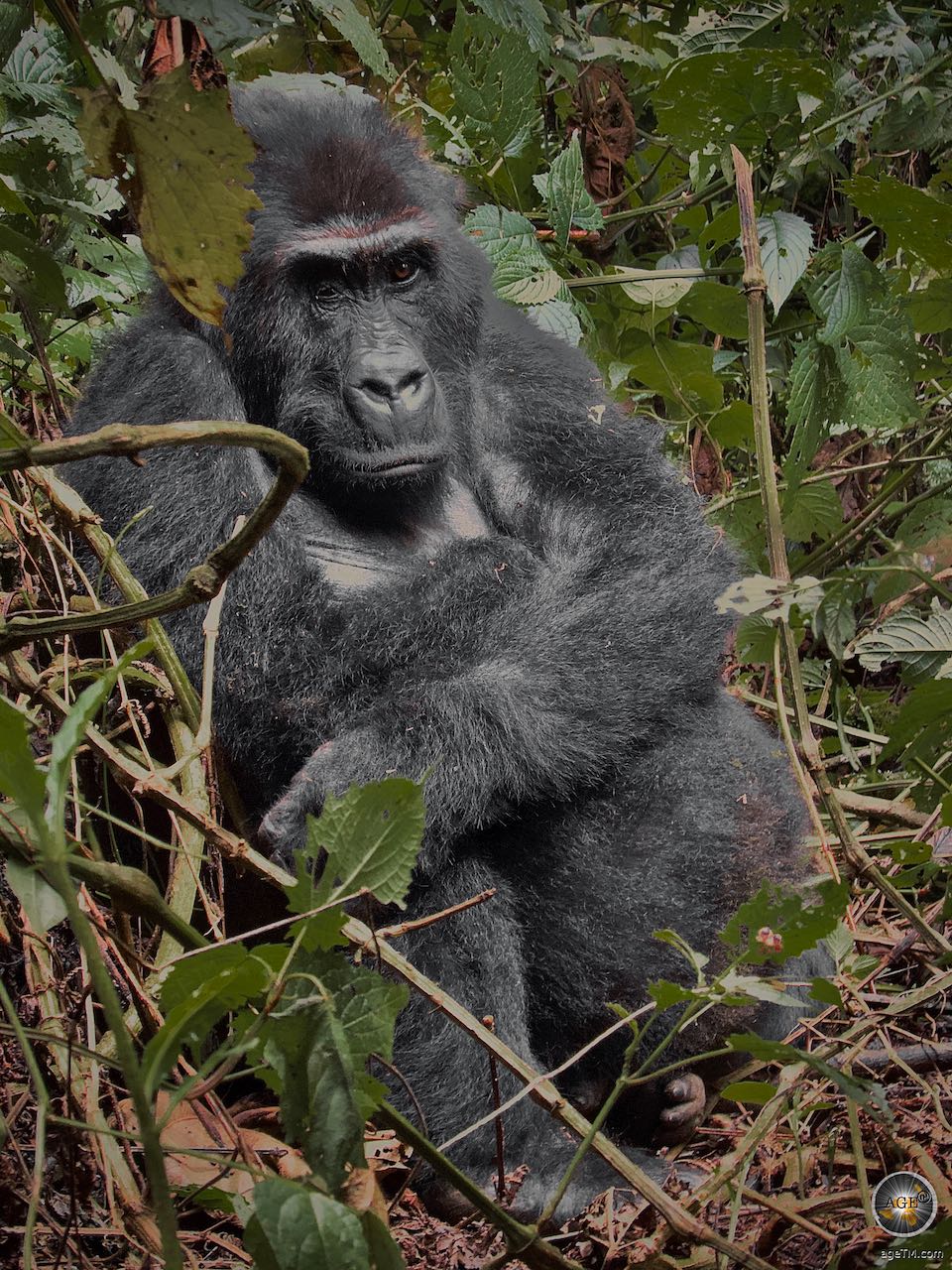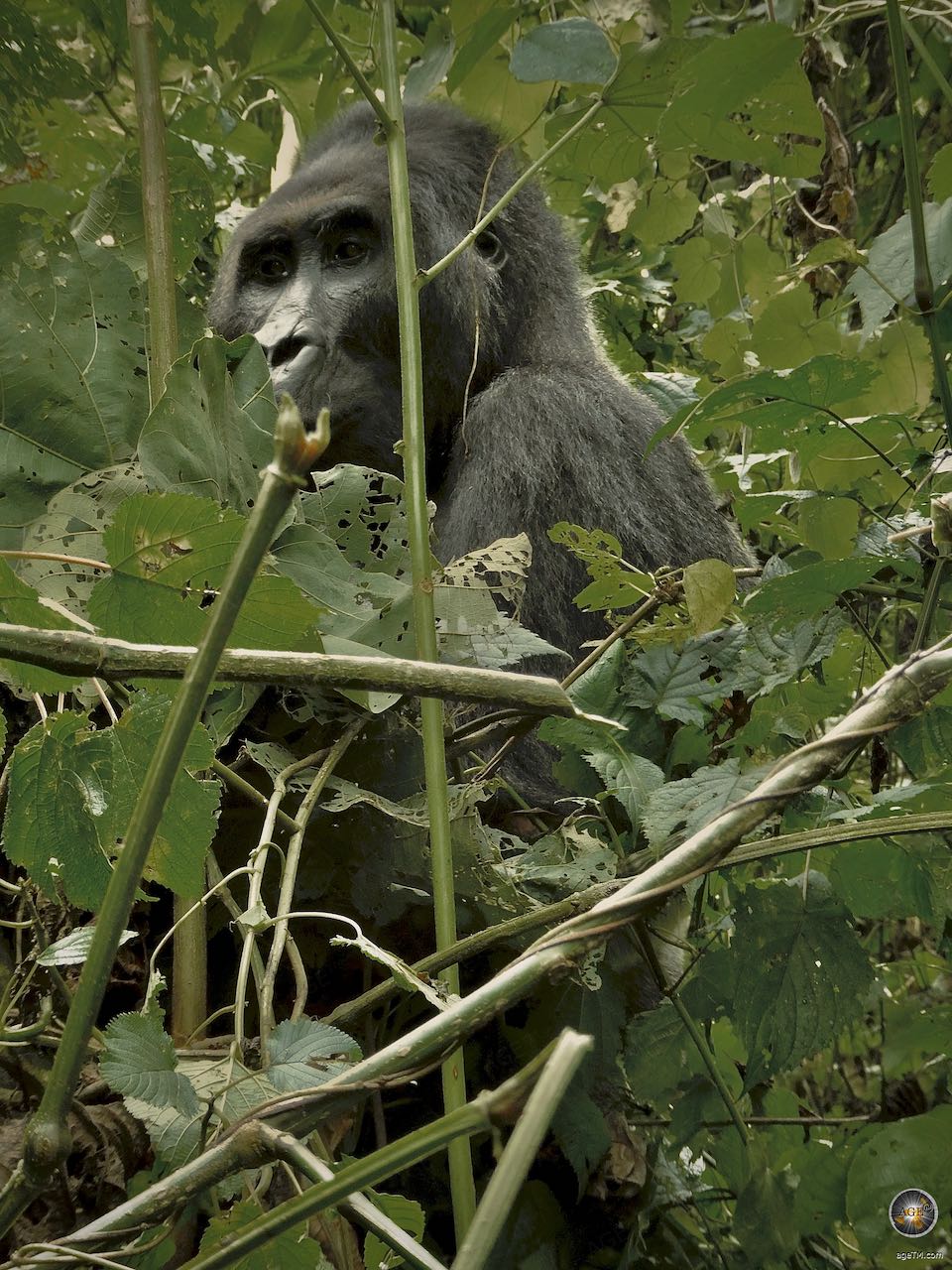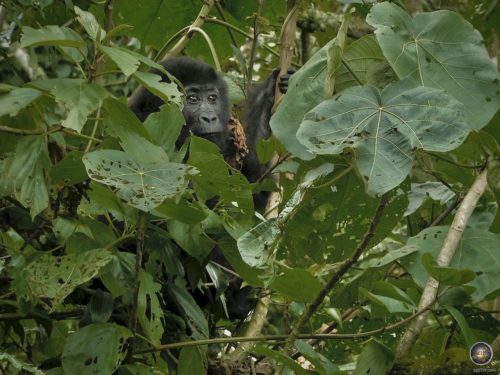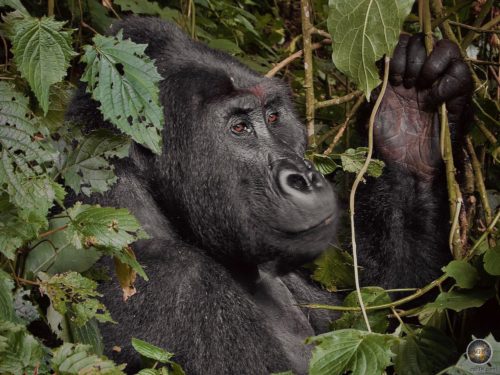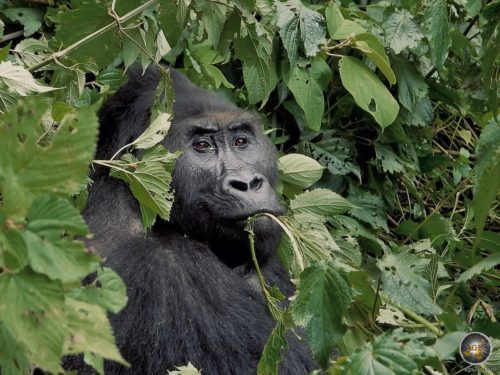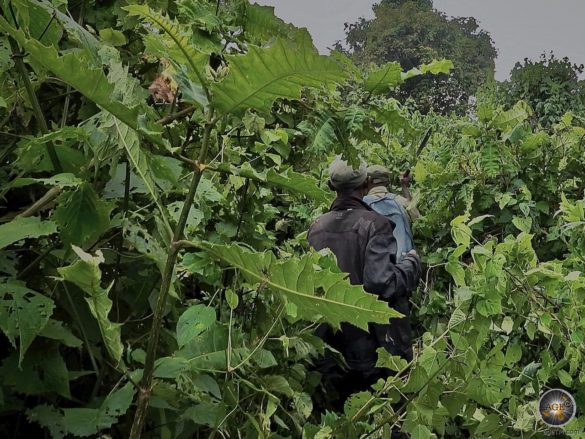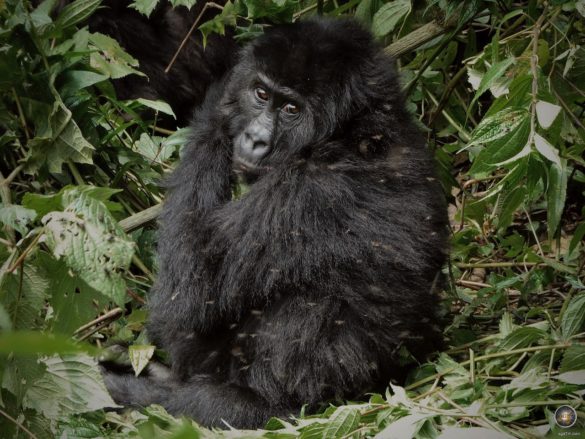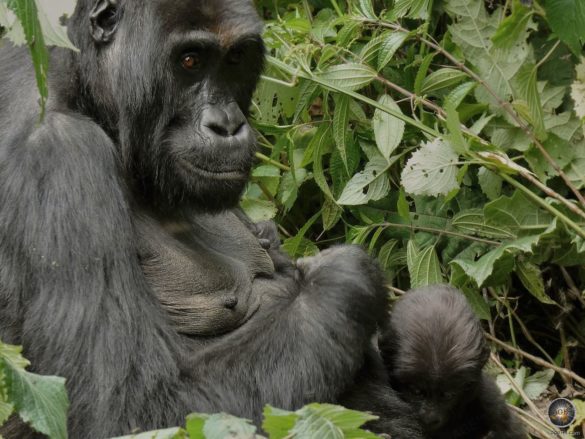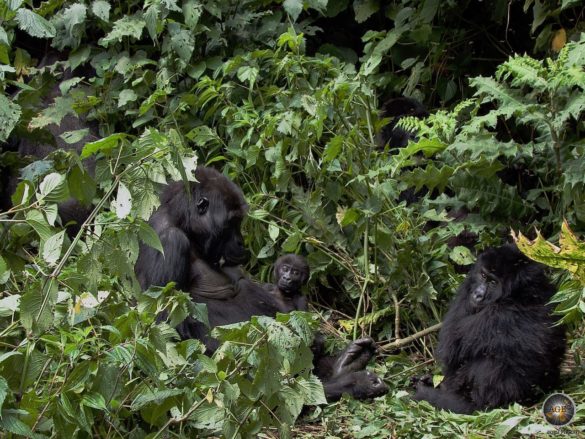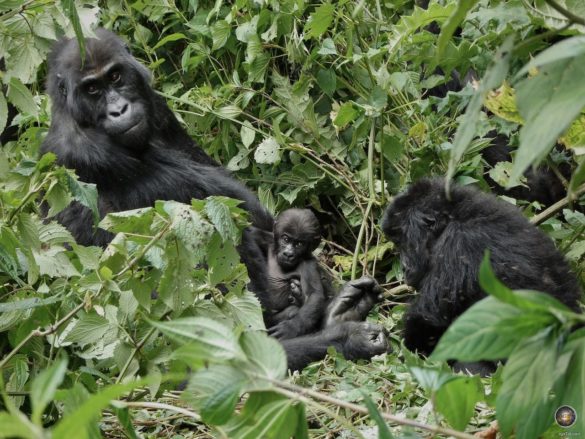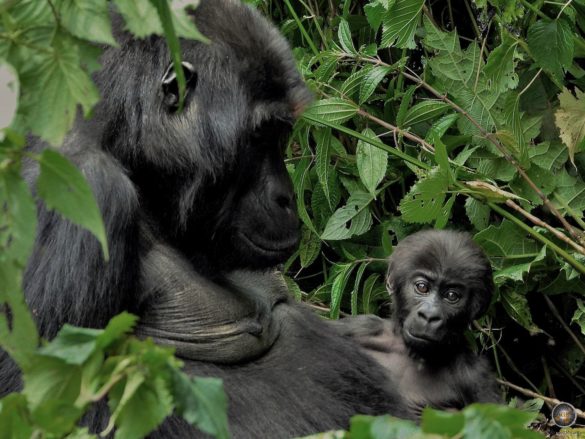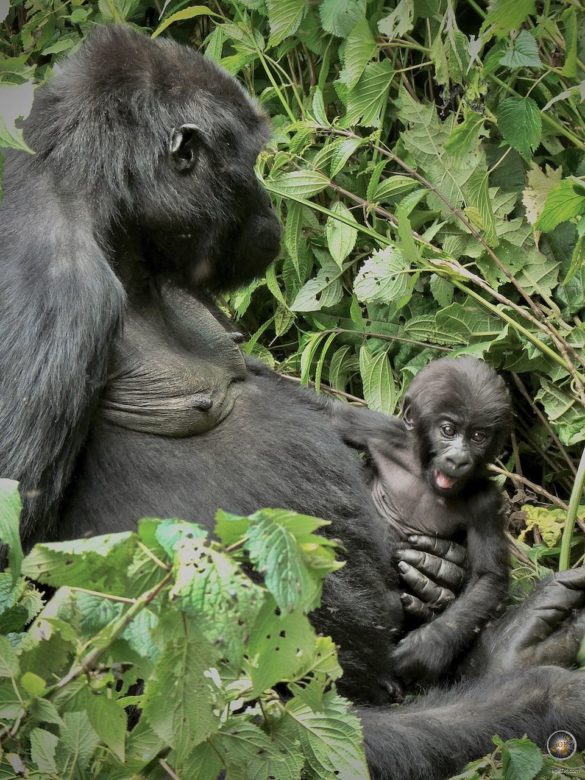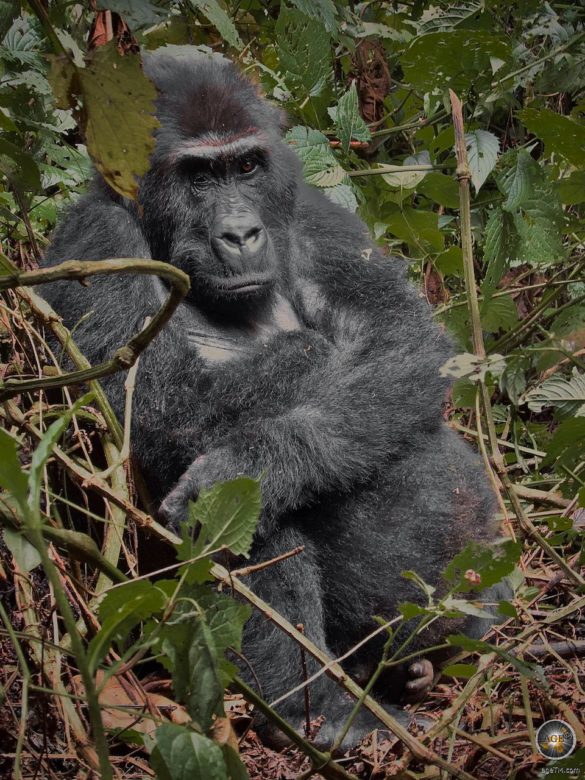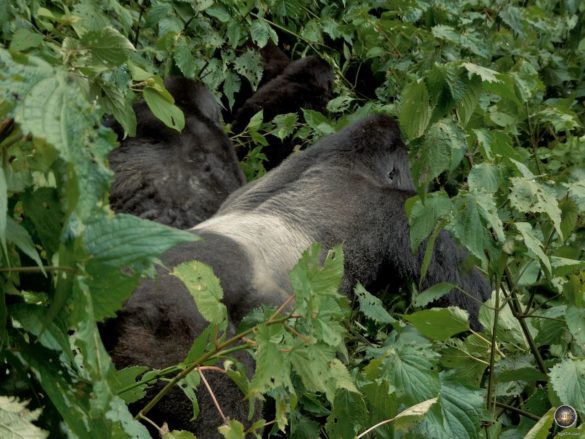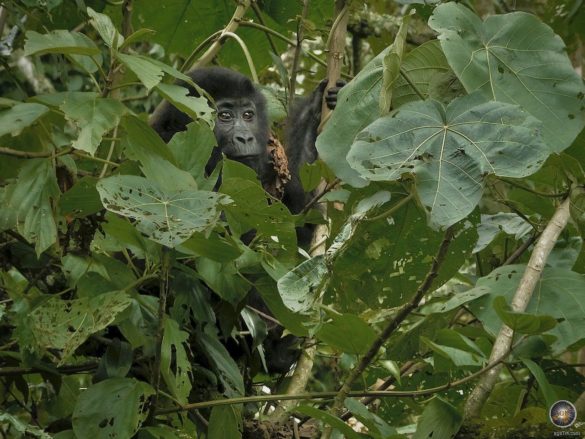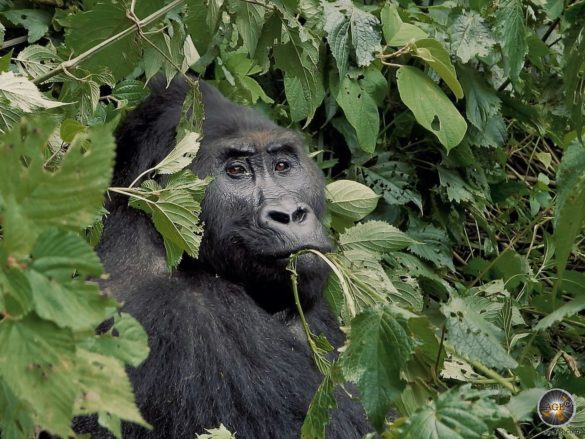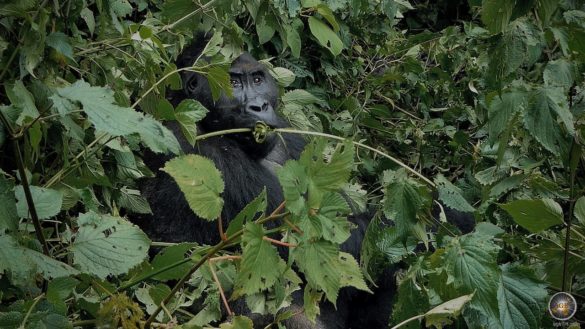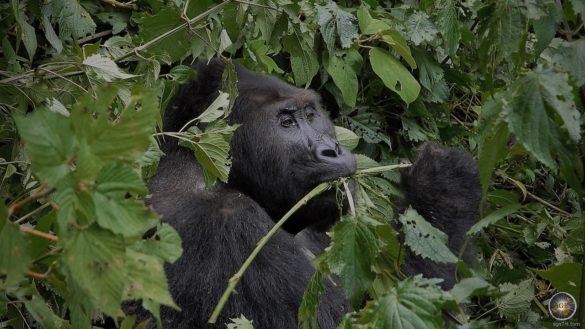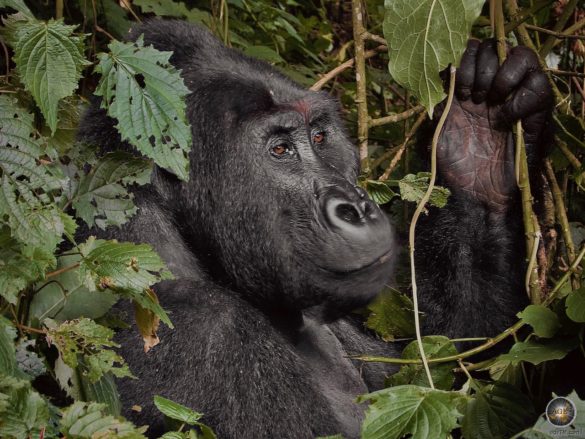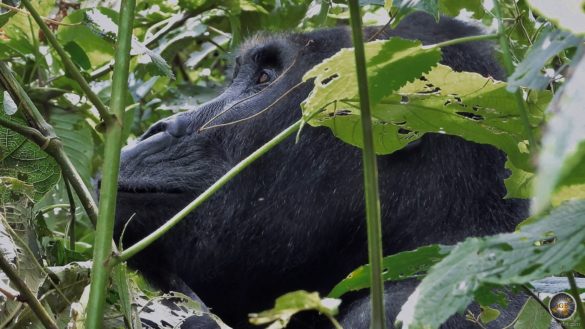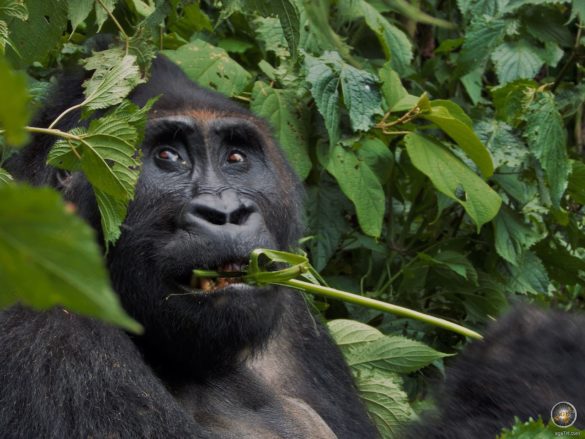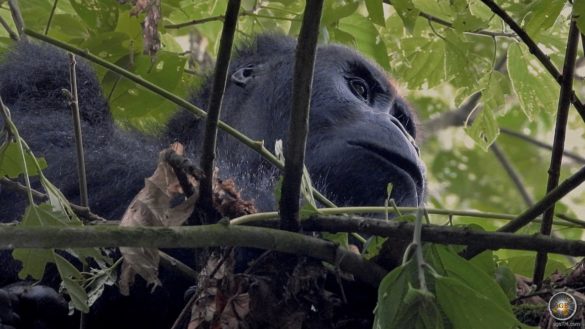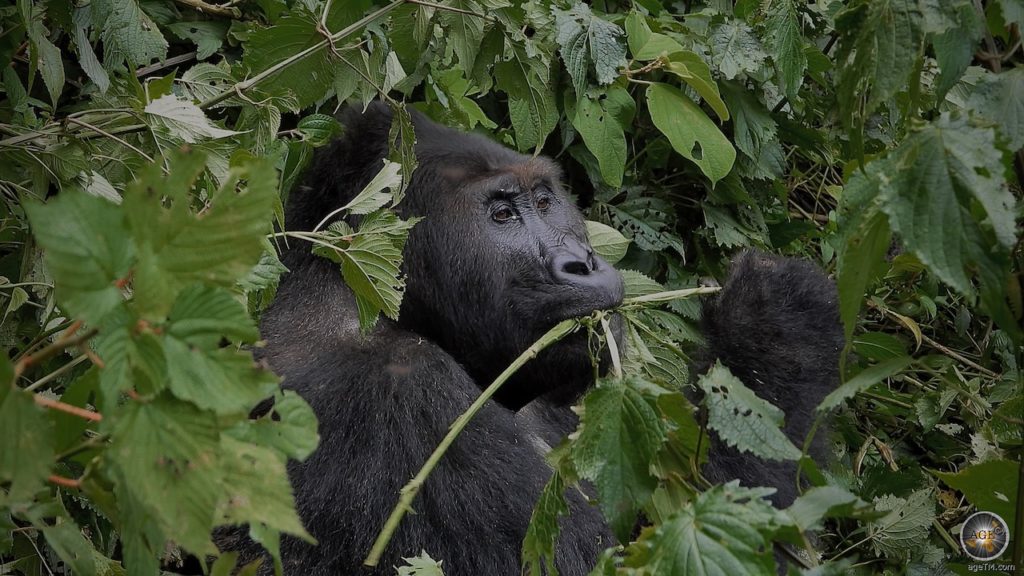
Where is Gorilla trekking in the wild possible? What is there to see?
And how does it feel to stand in front of the silverback in person?
AGE ™ has Lowland gorillas in Kahuzi Biega National Park (DRC)
and Mountain gorillas in the Bwindi Impenetrable Forest (Uganda) observed.
Join us on this impressive experience.
Visiting relatives
Two awesome days of gorilla trekking
Our itinerary starts in Rwanda, makes a detour to the Democratic Republic of the Congo and ends in Uganda. All three countries offer several opportunities to observe great apes in their natural environment. So we are spoiled for choice. Which gorilla tour is the better? Do we want to see Eastern Lowland Gorillas or Eastern Mountain Gorillas?
But after a little research, the decision is surprisingly easy, because mountain gorilla trekking in Rwanda would have been more expensive than visiting the lowland gorillas in DRC (Info about prices) and the mountain gorillas in Uganda. A clear argument against Rwanda and at the same time a good argument for hitting the bush twice and experiencing both subspecies of the eastern gorillas. No sooner said than done: Despite all travel warnings, we decide to give the DR Congo and its lowland gorillas a chance. Uganda was on the agenda anyway. This completes the route.
The plan: Get very close to our largest relatives on gorilla trekking with a ranger and in a small group. Respectful but personal and in their natural environment.
wildlife viewing • great apes • Africa • Lowland gorillas in DRC • Mountain gorillas in Uganda • Gorilla trekking live • Diashow
Gorilla trekking in DRC: Eastern lowland gorillas
Khahuzi Biega National Park
Kahuzi-Biega National Park in the Democratic Republic of the Congo is the only place where tourists can see eastern lowland gorillas in the wild. The park has 13 gorilla families, two of which are habituated. That means they are used to the sight of people. With a bit of luck, we will soon face one of these families. In other words: We are looking for the silverback Bonane and his family with 6 females and 5 pups.
For avid hikers, gorilla trekking is a beautiful walk through rough terrain of gorgeous shades of green and varied vegetation. However, for those who just want to see gorillas for a short time, gorilla trekking can be very challenging. We've been walking through dense forest for an hour already. there are no paths.
Most of the time we walk on trampled tangles of plants that cover the ground and form a kind of undergrowth. The branches give way. Hidden bumps are often not recognized until late. Sturdy shoes, long trousers and a little concentration are therefore a must.
Again and again we stop while our ranger opens the way with his machete. We tucked the pant legs into the socks to protect ourselves from ants. We are five tourists, three locals, a porter, two trackers and a ranger.
The ground is surprisingly dry. After hours of heavy rain last night I expected mud puddles, but the forest shielded and absorbed everything. Luckily the rain stopped on time this morning.
- The ranger goes ahead with his machete in gorilla trekking.
Finally we pass an old nest. Long tufts of grass and leafy plants lie loosely piled up under a large tree and cushion the patch of earth for a cozy nap: a gorilla sleeping place.
"About 20 minutes left," informs our ranger. He has a message in which direction the gorilla family left this morning, because trackers were already out early in the morning to locate the group. But things should be different.
Only five minutes later we stop again to let the rest of the group catch up with us. A few machete blows should make our way easier, but suddenly the ranger stops in the middle of his movement. The space that opens up behind the green just removed is occupied. I catch my breath.
- Suddenly we are faced with the silverback.
The silverback sits just a few meters in front of us. As if in a trance, I stare at his imposing head and broad, strong shoulders. Only a few small leafy plants separate us from him. palpitations. That's what we're here for.
The silverback, however, seems very relaxed. Indifferently he nibbles on a few leaves and hardly notices us. Our ranger carefully removes a few more stalks to improve visibility for the rest of the group.
The silverback is not alone. In the thicket we spot two more heads and two shaggy young animals are sitting a little hidden from the leader. But shortly after our entire group has gathered around the gap in the bushes, the silverback gets up and trotts off.
It remains unclear whether the group of curious two-legged friends disturbed him after all, whether the ranger's last blow with his machete was too loud, or whether he simply chose a new feeding place for himself. Luckily, we were right at the front and were able to experience this fantastic moment of surprise live.
Two other animals follow the leader. Where they sat, a small clearing of flattened plants remains. One big and one small gorilla stay with us. The great gorilla is clearly and unmistakably a lady. Actually, we could have guessed that, because up to the eastern lowland gorillas there is always only one sexually mature male in the family, the silverback. Male cubs must leave the family when they get older. The little gorilla is a shaggy cub who is being besieged by some mosquitoes and looks a bit overwhelmed. A cuddly furball.
While we are still looking at the two gorillas and desperately hoping that they will remain seated, the next surprise awaits: a newborn baby suddenly lifts its head. Nestled close to Mama Gorilla, we almost missed the little one in our excitement.
- Female eastern lowland gorilla. If you look closely, you can see the baby's head in her lap.
- Gorilla cub in Kahuzi-Biega National Park DRC – Eastern lowland gorilla (Gorilla beringei Graueri)
- Mama gorilla Siri with a 3-month-old baby gorilla in the DRC jungle, alongside an older cub.
The baby gorilla is by far the youngest member of the gorilla family. It's only three months old, our ranger knows. The small hands, the gestures between mother and child, the innocent curiosity, all of this seems incredibly human. The offspring clambers a bit awkwardly onto mum's lap, pats their little hands around and looks at the world with big, round saucer eyes.
For the next three years, the little one is sure of his mother's full attention. "Gorillas nurse for three years and have offspring only every four years," I recall saying at the briefing this morning. And now I'm standing here, in the middle of the Congolese bush, only a good 10 meters away from a gorilla and watching a sweet baby gorilla playing. What luck!
- Female gorilla with baby gorilla: Eastern lowland gorillas in Kahuzi-Biega National Park, DRC
- Gorilla Baby Portrait Offspring of the endangered Eastern lowland gorillas in the wild Democratic Republic of Congo
Out of sheer excitement I even forget to film. Just as I press the shutter button to capture a few moving images as well, the spectacle comes to an abrupt end. Mama gorilla grabs her baby and struts away. A few moments later, the shaggy cub hops into the undergrowth, leaving the small group of onlookers breathless.
In total, this gorilla family counts 12 members. We were able to observe four of them well and briefly saw two more. In addition, we had quite a considerable cross-section of ages: mom, baby, big brother and the silverback himself.
Actually perfect. Nevertheless, we would of course like to have more.
During gorilla trekking, time with the animals is limited to a maximum of one hour. The time is running from the first sight contact, but we still have some time left. Maybe we can wait for the group to come back?
Even better: We don't wait, we search. The gorilla trekking continues. And after just a few meters through the thicket, our ranger finds another gorilla.
- Female gorilla Mukono with eye injury in Kahuzi-Biega National Park, DRC
The lady sits with her back against a tree, arms crossed and awaits things to come.
The ranger calls her Munkono. As a cub, she was injured in a trap set by poachers. Her right eye and right hand are missing. We immediately noticed the eye, but the right hand always keeps it protected and concealed.
She dreams to herself, scratches herself and dreams on. Munkono is fine, fortunately the injuries have been over for many years. And if you look closely, you will see something else: she is very tall.
A short distance away, the branches suddenly wobble, drawing our attention. We approach cautiously: it is the silverback.
He stands in the dense green and feeds. Sometimes we catch a glimpse of his expressive face, then it disappears again in the tangle of leaves. Again and again he reaches for tasty leaves and stands up to his full height in the thicket. With a height of around two meters, the eastern lowland gorillas are the largest gorillas and thus the largest primates in the world.
We watch his every move with fascination. He chews and picks and chews again. When chewing, the muscles on his head move and remind us who is standing in front of us. It seems tasty. A gorilla can eat up to 30 kg of leaves a day, so the silverback still has some plans.
Then everything happens very quickly again: from one second to the next, the silverback suddenly moves on. We try to understand the direction and also change positions. Through a small gap of lower vegetation we just see it pass by.
On four legs, from behind and in motion, the silvery border on his back comes into its own for the first time. A young animal unexpectedly hops past directly behind the leader, which underlines the imposing size of the silverback. A moment later the little one is swallowed up by the dense vegetation.
But we have already discovered something new: a young gorilla has appeared in the treetop and suddenly looks down on us from above. He seems to find us just as interesting as we do him and peeks out curiously from between the branches.
- The silverback roams the jungle with his gorilla family.
- A gorilla cub looks down on us from a tree while gorilla trekking.
- Young gorilla in the forest of Kahuzi-Biega National Park, DRC
Meanwhile, the gorilla family follows the silverback and we try the same. With a safe distance, of course. Three more backs of gorillas have appeared in the light green next to their leader. Then the group suddenly stops again.
And again we are lucky. The silverback settles very close to us and starts feeding again. This time there are hardly any plants between us and I almost feel like I'm sitting next to him. He is incredibly close to us. This encounter is far more than I could have hoped for from gorilla trekking.
- The imposing silverback chews leaves. His hand is impressively human.
Our ranger is about to remove more brush with the machete, but I hold him back. I don't want to risk disturbing the silverback and I would like to stop time at the same time.
I crouch down, breathless, and face the huge gorilla in front of me. I hear his smacking and look into his beautiful brown eyes. I want to take this moment home with me.
I look at the silverback's face and try to memorize its distinctive facial features: the prominent cheekbone, the flattened nose, the small ears and the movable lips.
He casually fishes the next branch. Even sitting down, he looks huge. When he lifts his strong upper arm, I see his muscular chest. Any body pic would be jealous. His large hand encloses the branch. She looks incredibly human.
- Eastern lowland gorillas eat leaves, fruit, and bamboo shoots.
That gorillas belong to the great apes is no longer a systematic classification for me, but tangible fact. We are relatives, no doubt.
A look at the broad, hairy shoulders and the strong neck quickly reminds me who is sitting in front of me: the gorilla leader himself. The high forehead makes his face appear even more massive and imposing.
Visibly satisfied, the silverback stuffs another handful of leaves into his mouth. Stalk after stalk is eaten up. He clamps the branch between his lips and skilfully strips off all the leaves with his teeth. He leaves the harder stalk. Pretty picky a gorilla.
When the silverback finally sets off again, a glance at the clock reveals that we won't be following him this time. Our gorilla trekking is coming to an end, but we are overjoyed. An hour has never felt so long. As if to say goodbye, we pass under a tree that has obviously just been taken over by half the gorilla family. There is lively activity in the branches. One last look, one last photo and then we trudge back through the forest - with a big smile on our faces.
- Gorilla Portrait: Intense eye contact while gorilla trekking
- Eastern lowland gorilla in a tree in Kahuzi-Biega National Park, DRC
Fun facts about silverback Bonane and his family
Bonane was born on January 01st, 2003 and was therefore called Bonane, which means New Year
Bonane's father is Chimanuka, who for a long time led the largest family in Kahuzi-Biéga with up to 35 members
In 2016, Bonane fought Chimanuka and took his first two females with him
In February 2023 his family numbered 12 members: Bonane, 6 females & 5 young
Two of Bonane's cubs are twins; The mother of the twins is the female Nyabadeux
The baby gorilla we observed was born in October 2022; His mother is named Siri
Gorilla lady Mukono is missing an eye and the right hand (probably due to a fall injury as a cub)
Mukono is heavily pregnant at the time of our gorilla trekking: she gave birth to her baby in March 2023
wildlife viewing • great apes • Africa • Lowland gorillas in DRC • Mountain gorillas in Uganda • Gorilla trekking live • Diashow
Gorilla trekking in Uganda: Eastern mountain gorillas
Bwindi Impenetrable Forest
This text is still in progress.
Do you also dream of watching gorillas in their natural habitat?
The AGE™ article Eastern lowland gorillas in Kahuzi-Biéga National Park, DRC helps you with the planning.
Also information about Arrival, price and safety we have summarized for you.
The AGE™ article Eastern Mountain Gorillas in Bwindi Impenetrable Forest, Uganda will soon answer your questions.
For example, we put together information about the location, minimum age and costs for you.
wildlife viewing • great apes • Africa • Lowland gorillas in DRC • Mountain gorillas in Uganda • Gorilla trekking live • Diashow
Enjoy the AGE™ Image Gallery: Gorilla Trekking - Visiting Relatives.
(For a relaxed slide show in full format, simply click on a photo and use the arrow key to move forward)
wildlife viewing • great apes • Africa • Lowland gorillas in DRC • Mountain gorillas in Uganda • Gorilla trekking live • Diashow
Information on site, briefing in the information center of the Kahuzi-Biega National Park, as well as personal experiences with gorilla trekking in the German Republic of Congo (Kahuzi-Biega National Park) and with gorilla trekking in Uganda (Bwindi Impenetrable Forest) in February 2023.
Dian Fossey Gorilla Fund Inc. (21.09.2017/26.06.2023/XNUMX) Studying Grauer's gorilla behaviors. [online] Retrieved on XNUMX/XNUMX/XNUMX, from URL: https://gorillafund.org/congo/studying-grauers-gorilla-behaviors/
Gorilla Doctors (22.03.2023/26.06.2023/XNUMX) Busy Boy Bonane – A Newborn Grauer's Gorilla. [online] Retrieved on XNUMX/XNUMX/XNUMX, from URL: https://www.gorilladoctors.org/busy-boy-bonane-a-newborn-grauers-gorilla/
Kahuzi-Biéga National Park (2017) Standard Rates for Safari Activities in Kahuzi Biega National Park. [online] Retrieved on 28.06.2023/XNUMX/XNUMX, from URL: https://www.kahuzibieganationalpark.com/tarrif.html

